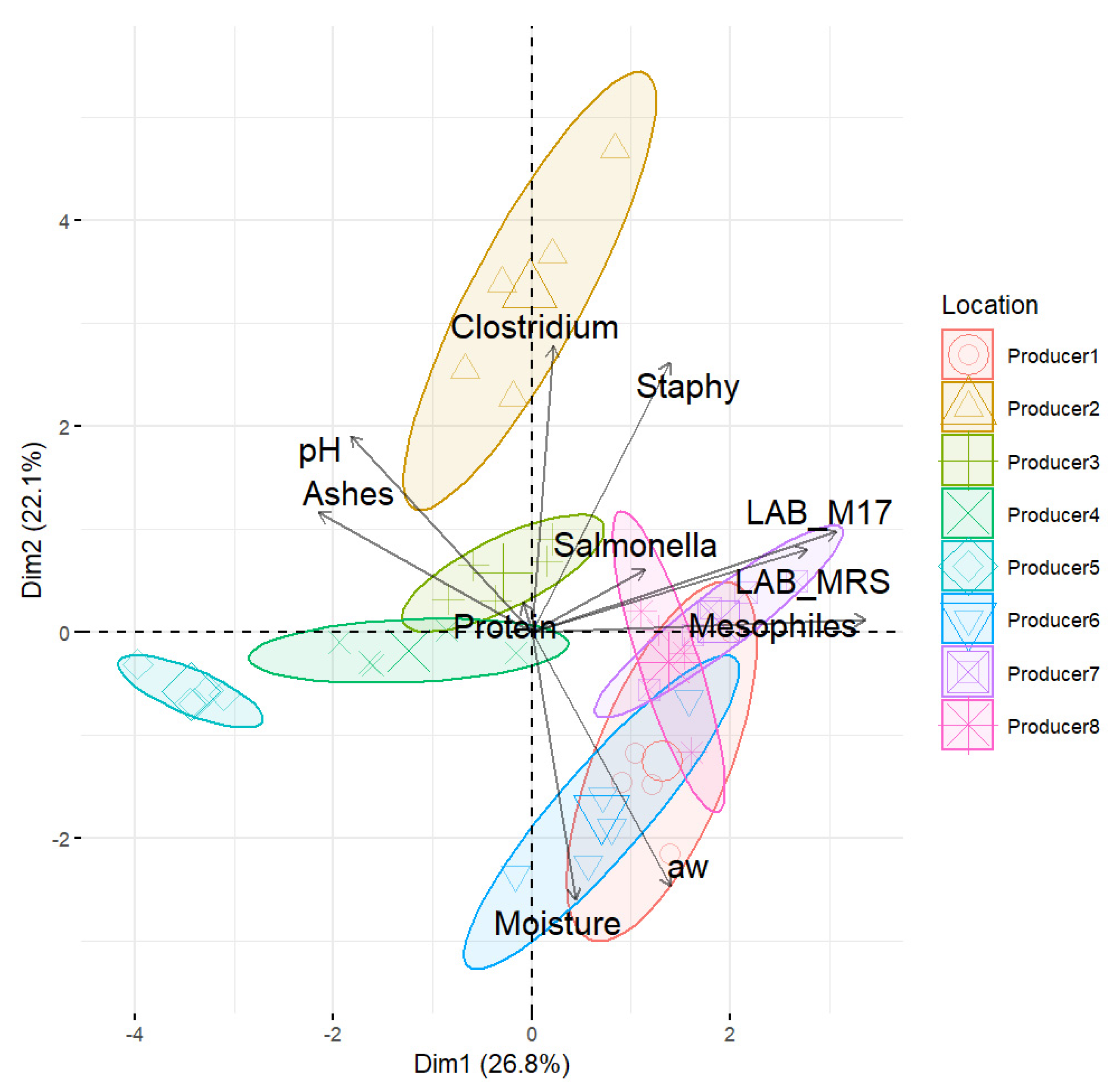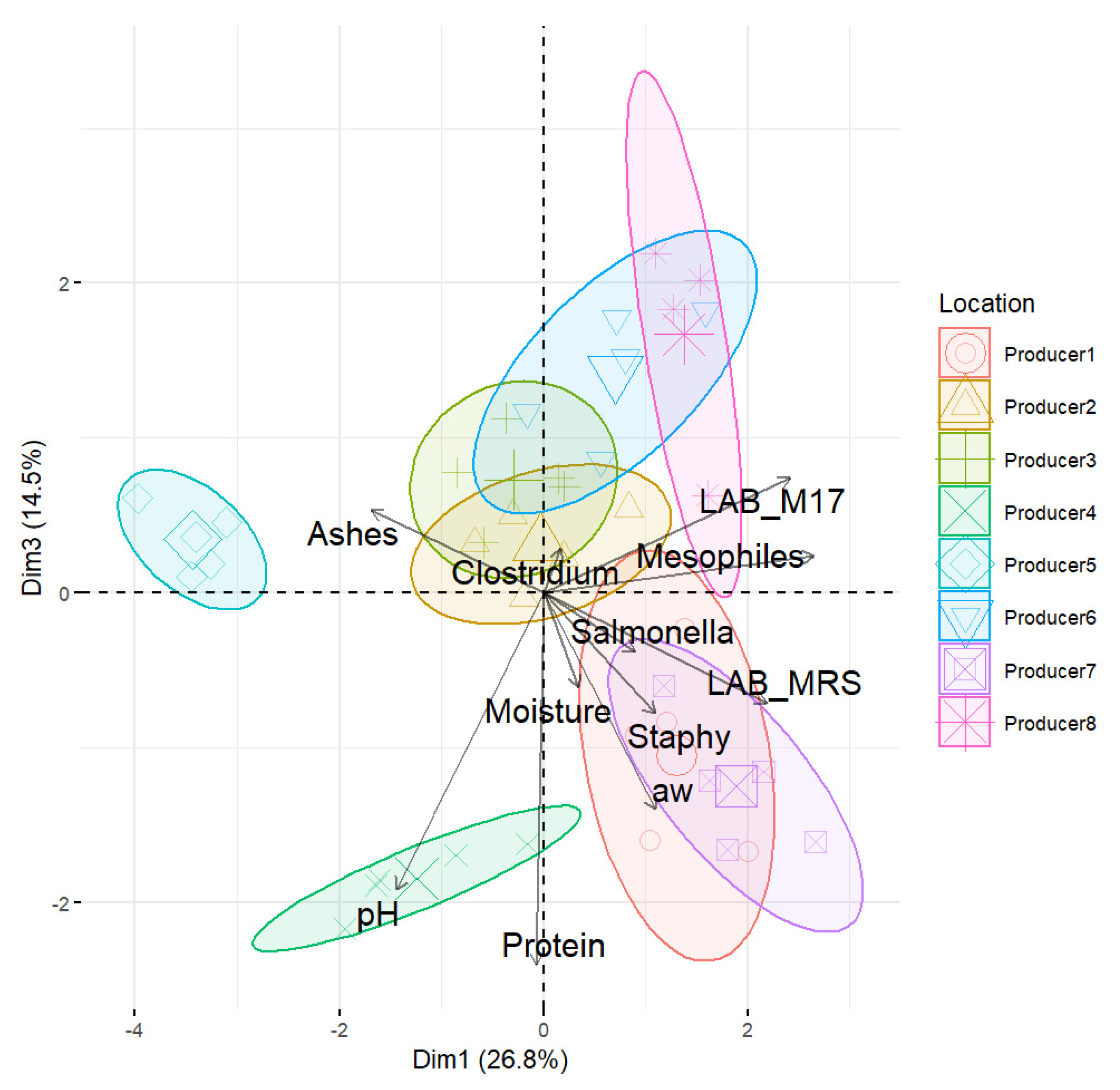1. Introduction
In Portugal, there is a long history of elaboration of ready-to-eat and non-ready-to-eat sausages. Alheira is a traditional non-ready-to-eat fermented sausage mainly produced by medium-sized enterprises and artisanal producers in northern Portugal. Traditionally, a mix of pork and poultry meat has been used in its elaboration, although recently other formulations based on cod fish or game meat are also available in the market. Cooked meats are shredded and mixed with salt, garlic, spices, and sliced bread soaked in hot broth to form a non-uniform paste. This paste is stuffed into natural casings, and left to dry and mature at cold temperatures for 7–14 days.
As occurs with most artisanal products, the quality characteristics of alheira—including physicochemical, nutritional, microbiological, and sensorial attributes—are highly variable not only between regional producers, but also between batches of production within the same enterprise [
1]. This occurs as a result of the different ingredients and their quality, different recipes, and different or not-sufficiently controlled processing variables and hygiene in their elaboration [
2]. The objective of this study was (i) to evaluate the variability in relevant physicochemical and microbiological attributes of alheira sausages elaborated by representative artisanal producers of northern Portugal; and (ii) to understand the associations between these attributes through the derivation of quality maps based on principal component analysis.
2. Materials and Methods
Five alheira sausages from the same production batch were obtained from 8 artisanal establishments located in the towns of Vila Real, Bragança, Chaves, Mirandela, Mogadouro, Miranda do Douro, Vimioso, and Valpaços, all of them belonging to the Portuguese northeastern region of Trás-Os-Montes. Sausages were purchased one or two days after production, and were subjected to physicochemical and microbiological analysis within 24 h after purchase. Casings were carefully removed from the sausages under aseptic conditions, and the contents were divided for physicochemical and microbiological analyses.
2.1. Physicochemical Analysis
The physicochemical determinations were pH, water activity (a
w), moisture, ashes, and protein content. The pH measurement was carried out in triplicate using a pH meter (Hanna Instruments, HI5522, Woonsocket, RL, USA) equipped with a HI1131 glass penetration probe. To measure a
w, alheira contents were transferred into the cuvette of an Aqualab meter (4TE Decagon, WA, USA), and the value was recorded after measurement stabilization. This was repeated three times per alheira sample. Moisture, protein, and ash contents were determined in duplicate according to ISO norms [
3,
4,
5]. Protein and ash contents were converted to dry basis (db) for statistical analysis.
2.2. Microbiological Analysis
The microbiological analysis consisted of quantification of total mesophiles, lactic acid bacteria, presumptive
Clostridium perfringens,
Staphylococcus aureus, and presence of
Salmonella spp., which were performed in duplicate. Total mesophiles were counted on Plate Count Agar (610040, Liofilchem, Roseto degli Abruzzi, Italy), while lactic acid bacteria (LAB) were counted on MRS and M17 agar, and confirmed by microscopy and biochemical tests [
6].
S. aureus was counted on Baird-Parker agar (610004, Liofilchem, Italy), supplemented with Egg Yolk Tellurite (80122, Liofilchem, Italy), following ISO norm [
7]. The analysis of
C. perfringens was carried out according to APHA [
8], using Tryptose Sulphite Cycloserin agar (DSHB3042, Alliance Bio Expertise, Guipry, France) enriched with egg yolk supplement (80219, Liofilchem, Italy) and cultured in anaerobiosis. The detection of
Salmonella spp. was undertaken according to BAM/FDA method [
9], using the following culture media: tetrathionate broth (610183, Liofilchem, Italy), Rappaport-Vassiliadis broth (610175, Liofilchem, Italy), Hektoen enteric agar (610021, Liofilchem, Italy), Bismute-Sulfite agar (610301, Liofilchem, Italy), Xylose Lysine Desoxycholate agar (DSHB3011, Alliance Bio Expertise, France). Typical colonies were serologically confirmed. For statistical analysis, a value of 0 was assigned to absence of
Salmonella in 25 g, and a value of 1 to presence of
Salmonella in 25 g.
2.3. Statistical Analysis
With the objective of summarizing the information provided by the physicochemical and microbiological characteristics as well as their interrelationships, the data were subjected to a principal component analysis (PCA). The function prcomp() and the library factoextra were utilized in the R software (version 3.6.2, R Foundation for Statistical Computing, Vienna, Austria), where a varimax-rotated solution for three principal components was obtained. From the three-dimensional PCA, maps of physicochemical and microbiological quality of alheiras were built from the projection of sample scores onto the span of the principal components. Scores were clustered by artisanal producer (i.e., location). Locations are not disclosed in the present study.
3. Results and Discussion
The physicochemical and microbiological quality of alheira sausages artisanally produced in the north of Portugal presented considerable variability, as deduced from the producer-specific mean values for mesophilic counts (7.161–9.679 log CFU/g), S. aureus counts (1.699–6.021 log CFU/g), presumptive C. perfringens (<0.699–1.699 log CFU/g), LAB counts (7.704–11.00 log CFU/g), pH (4.034–4.606), aw (0.9758–0.9969), moisture content (45.39–58.36%), protein content (17.78–28.00% db), and ash content (2.79–4.71% db). Salmonella spp. was detected in four of the eight sampled artisanal producers at an incidence of 0.20 (one positive sample out of the five samples tested).
The contribution of the original quality attributes to the principal components can be evaluated by their correlations with the three components extracted (
Table 1). A total of 63% of the variability in the 11 quality attributes was jointly explained by the three principal components. The first component (PC1) explained 26% of the total variability, and was highly correlated with mesophilic counts (R = 0.85), LAB counted on MRS agar (R = 0.79), LAB counted on M17 agar (R = 0.81), and more weakly correlated with
S. aureus (R = 0.58). Thus, PC1 can be labeled as
longer processing duration (or alternatively, fermentation efficiency), as longer fermentation/maturation times (or more efficient fermentations) tend to producer greater populations of mesophiles and LAB. In addition, if
S. aureus contaminates the sausage mixture, it can survive throughout processing if the drop in pH is not sufficient during the first stage of fermentation. On the other hand, if the matrix pH is lower than 5.6,
S. aureus cells become inactivated with further acidification [
10]. This would explain the weaker correlation of
S. aureus with PC1, since, in some cases, this pathogen can increase, and in others, it can decrease during processing. According to the quality map shown in
Figure 1, Producers 1, 6, 7, and 8 would employ a longer processing time for the production of alheira sausages or would have a more efficient fermentation process, whereas Producer 5 would produce alheiras in the shortest time or will have delayed fermentations.
The second component (PC2) explained 21% of the total variability, and was highly and inversely correlated with moisture content (R = −0.73) and a
w (R = −0.84), and directly correlated with presumptive
C. perfringens counts (R = 0.70;
Table 1). These inverse correlations imply that, in our sample set, drier alheiras tended to present higher counts of
C. perfringens. This pathogen may enter alheira sausages through raw meats because some strains are resistant to temperatures as high as 100 °C for more than an hour. Spores that survive cooking may germinate and grow rapidly in the meat cooking broth that is left to cool down, as this is a common procedure in the elaboration of alheira sausages. Furthermore, the oxygen level is sufficiently reduced during stuffing to permit growth of clostridia. Nonetheless, in all alheira samples, presumptive
C. perfringens concentrations were lower than 2.7 log CFU/g. Due to the inverse relationship between the water-related variables with PC2, this component was labeled as
greater dehydration. A greater dehydration of alheira sausages can arise from longer drying times or higher drying temperatures. The quality map of
Figure 1 illustrates that Producers 1, 6, and 8 produced sausages of overall higher moisture content, yet, at the same time, of variable moisture (i.e., larger ellipses along PC2 axis). On the other hand, Producers 3, 4, and 5 elaborated drier sausages of more consistent moisture content (i.e., smaller ellipses along PC2). Finally, Producer 2 elaborated the most dehydrated sausages, although it can be inferred from the degree of dispersion, that their drying process may be not fully controlled.
The third component (PC3) explicated 16% of the data variability, and presented high loadings on only two variables, pH (R = 0.86) and protein content (R = 0.78). Because, in alheira sausages, the main source of protein is the meat, PC3 can be labeled as higher meat proportion in the formulation. One of the reasons why protein content and pH of alheiras could be highly associated (
Figure 2) may reside in the probable tendency of artisanal producers to use pig meat of high pH (i.e., DFD meats). In an earlier study conducted on a Portuguese ready-to-eat sausage, it was found that the pH of the final product positively correlated with the pH of the raw pig meat [
11]. On the other hand, in the formulation of alheira, the main ingredients are meat and bread. Formulations that have a lower proportion of meat are compensated with a higher proportion of regional bread, which is a foodstuff of lower pH (5.1–5.4) than the former. Thus, batters of higher proportion of meat will tend to have higher pH. The quality map of
Figure 2 suggests that Producers 1, 4, and 7 employed a higher concentration of meat in their formulations.
Two of the variables—ash content and
Salmonella spp.—did not yield high or at least moderate loadings in any of the principal components. The presence of
Salmonella spp. occurs as a random event that is not related to longer fermentation times, greater drying, or higher meat content. For the other pathogens studied, nonetheless, it is worth mentioning that the populations of
C. perfringens and
S. aureus were correlated (
Figure 1), which could point out that poor manufacturing practices are linked to poor hygiene conditions. In any case, food safety knowledge must be reinforced in the Portuguese artisanal producers
Projection of samples in the three-dimensional space allowed the differentiation of three clusters of factories: one made up of 4 factories that represent microbiologically safe alheiras of higher LAB concentration and lower pH. Another quality cluster of 3 factories described meat-rich alheiras of higher pH and protein content. A third cluster of one single factory was identified, representing poor quality alheiras that were drier, with a higher incidence of pathogenic bacteria, and a lower proportion of meat in the formulation.












